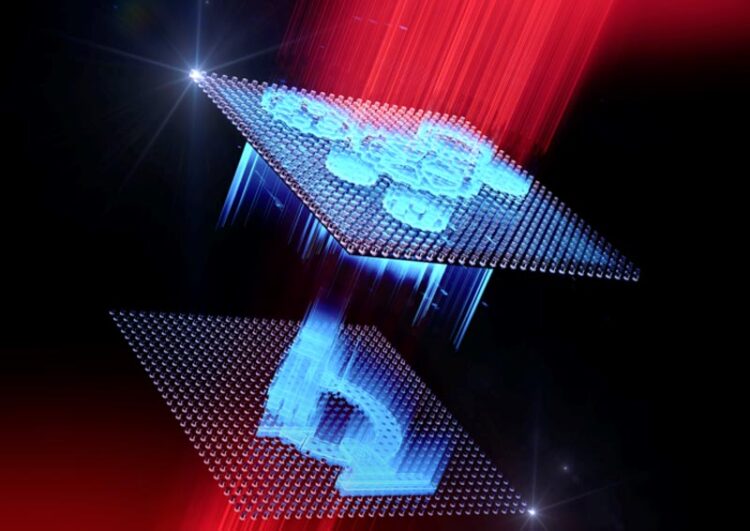Nanoparticles control flow of light like road signs direct traffic

An illustration of the ANU tiny slides
Credit: Ella Maru Studio
Physicists at The Australian National University (ANU) have developed tiny translucent slides capable of producing two very different images by manipulating the direction in which light travels through them.
As light passes through the slide, an image of Australia can be seen, but when you flip the slide and look again, an image of the Sydney Opera House is visible. The pair of images created is just one example of an untapped number of possibilities.
The ability to produce two distinctly different images is possible thanks to the ANU scientists’ ability to control the direction in which light can and can’t travel at the nanoscale. The development could pave the way for new light-based devices that could lead to faster, cheaper and more reliable Internet. It could also serve as the foundation for many of the technologies of tomorrow.
Developed in collaboration with colleagues from China, Germany and Singapore, the new technology uses nanoparticles, so small that about 12,000 of them can fit within a cross-section of a human hair. These tiny particles are arranged into unique patterns on the slides.
“The particles control the flow of light like road signs control traffic on a busy road by manipulating the direction in which light can, or can’t, travel,” project leader Dr Sergey Kruk said.
“Some particles allow light to flow from left to right only, others from right to left or the pathway might be blocked in either direction.”
Dr Lei Wang, from Southeast University in China said: “While the purpose of these images is mainly artistic, they demonstrate the potential for this new technology.
“In real-world applications these nanoparticles can be assembled into complex systems that would control the flow of light in a useful manner – such as in next-generation communications infrastructure.”
According to Dr Kruk, the ability to control the flow of light at the nanoscale ensures light “goes where it’s supposed to go and doesn’t go where it’s not supposed to”.
“We exchange enormous amounts of information with the help of light. When you make a video call, say, from Australia to Europe, your voice and image get converted into short pulses of light that travel thousands of kilometres through an optical fibre over the continents and oceans,” Dr Kruk, from the ANU Nonlinear Physics Centre, said.
“Unfortunately, when we use current light-based technologies to exchange information a lot of parasitic effects might occur. Light might get scattered or reflected, which compromises your communication.
“By ensuring light flows exactly where it needs to flow, we would resolve many issues with current technologies.”
According to Dr Kruk, the development of many technologies of tomorrow will rely heavily on our ability to control light at a tiny scale.
“A wide deployment of tiny components that can control the flow of light could potentially bring technological and social changes similar to transformations brought about in the past by the development of tiny components that control the flow of electricity, which are known as diodes and transistors,” he said.
“Control over the flow of electricity at the nanoscale is what ultimately brought us modern computers and smartphones. It is therefore exciting to envision the potential of our emerging technology for controlling flow of light.”
This research was a collaboration between the Nonlinear Physics Centre at the ANU Research School of Physics, Paderborn University in Germany, Southeast University in China and A*STAR Singapore.
The research is published in Nature Photonics.
Journal: Nature Photonics
DOI: 10.1038/s41566-022-01018-7
Subject of Research: Not applicable
Article Title: Asymmetric parametric generation of images with nonlinear dielectric metasurfaces
All latest news from the category: Physics and Astronomy
This area deals with the fundamental laws and building blocks of nature and how they interact, the properties and the behavior of matter, and research into space and time and their structures.
innovations-report provides in-depth reports and articles on subjects such as astrophysics, laser technologies, nuclear, quantum, particle and solid-state physics, nanotechnologies, planetary research and findings (Mars, Venus) and developments related to the Hubble Telescope.
Newest articles

First-of-its-kind study uses remote sensing to monitor plastic debris in rivers and lakes
Remote sensing creates a cost-effective solution to monitoring plastic pollution. A first-of-its-kind study from researchers at the University of Minnesota Twin Cities shows how remote sensing can help monitor and…

Laser-based artificial neuron mimics nerve cell functions at lightning speed
With a processing speed a billion times faster than nature, chip-based laser neuron could help advance AI tasks such as pattern recognition and sequence prediction. Researchers have developed a laser-based…

Optimising the processing of plastic waste
Just one look in the yellow bin reveals a colourful jumble of different types of plastic. However, the purer and more uniform plastic waste is, the easier it is to…


